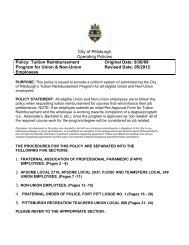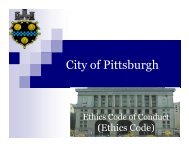east liberty station: realizing the potential - City of Pittsburgh
east liberty station: realizing the potential - City of Pittsburgh
east liberty station: realizing the potential - City of Pittsburgh
Create successful ePaper yourself
Turn your PDF publications into a flip-book with our unique Google optimized e-Paper software.
infrastructure for Eastside III & IV are<br />
expected to exceed $12 million with<br />
approximately $13 million <strong>of</strong> additional<br />
costs tied to <strong>the</strong> Eastern Gateway<br />
Intermodal Center (EGIC)<br />
Public financial assistance is necessary<br />
to fill <strong>the</strong> funding gap that results from<br />
<strong>the</strong>se improvements. A top priority within<br />
<strong>the</strong> study area, <strong>the</strong> EGIC and associated<br />
Eastside site infrastructure will enable<br />
mode sharing and vastly improve<br />
connectivity. More active land use in <strong>the</strong><br />
immediate vicinity <strong>of</strong> <strong>the</strong> new <strong>station</strong> will<br />
yield numerous benefits, especially<br />
increase transit utilization. As identified in<br />
<strong>the</strong> 2010 Community Plan, <strong>the</strong> significant<br />
transit assets in this Eastern Gateway<br />
geographic zone can be built upon to<br />
facilitate fur<strong>the</strong>r revitalization throughout<br />
<strong>the</strong> neighborhood.<br />
At full build-out, <strong>the</strong> project will generate<br />
an estimated $723,864 <strong>of</strong> annual<br />
incremental real property tax and an<br />
additional $370,610 <strong>of</strong> income tax for<br />
<strong>potential</strong> capture. The value capture<br />
strategy provides <strong>the</strong> option for a standalone<br />
financing specific to <strong>the</strong> project and<br />
its funding gap. These incremental<br />
revenues could support approximately<br />
$3.25 million <strong>of</strong> TRID debt obligations or<br />
$5.5 million if income taxes are also<br />
pledged to debt repayment. Due to<br />
required coverage, excess increment<br />
would be available annually after<br />
payment <strong>of</strong> debt service. These funds<br />
could be made available for contribution<br />
to <strong>the</strong> VC Fund or to reimburse eligible<br />
project costs. Under this scenario<br />
an additional $4.3 million could be<br />
provided to <strong>the</strong> developer over <strong>the</strong><br />
term <strong>of</strong> <strong>the</strong> financing with $1.4 million<br />
flowing back to <strong>the</strong> fund. Several<br />
district-wide TIF models across <strong>the</strong><br />
country provide assistance only in <strong>the</strong><br />
form <strong>of</strong> repayment for eligible project<br />
costs.<br />
Due to <strong>the</strong> extraordinary public<br />
infrastructure cost associated with<br />
site development and <strong>the</strong> <strong>station</strong><br />
area, this scenario assumes 100% <strong>of</strong><br />
<strong>the</strong> <strong>City</strong> and County real property tax<br />
increment is pledged to <strong>the</strong> TRID. A<br />
diversion <strong>of</strong> 40% <strong>of</strong> annual School<br />
District revenues is assumed in line<br />
with <strong>the</strong> local TIF policy. Finally, if<br />
income taxes are also part <strong>of</strong> <strong>the</strong><br />
TRID financing it is assumed <strong>the</strong> <strong>City</strong><br />
and School District will each pledge<br />
1%. These assumptions are for<br />
example only and subject to change<br />
pending review by <strong>the</strong> TRID<br />
Management Entity. Again, <strong>the</strong><br />
implementation strategy aims to<br />
provide flexibility to account for<br />
circumstances such as <strong>the</strong> availability<br />
<strong>of</strong> o<strong>the</strong>r funding assistance to <strong>of</strong>f-set<br />
project costs. Appendix II includes a<br />
full analysis <strong>of</strong> incremental tax<br />
revenues generated by <strong>the</strong> project<br />
and <strong>potential</strong> TRID debt structure.<br />
The o<strong>the</strong>r projects within <strong>the</strong> initial<br />
elTRID value capture area do not<br />
require such large site specific public<br />
infrastructure improvements as to<br />
warrant an upfront financing.<br />
Incremental revenues generated<br />
upon <strong>the</strong>ir completion would contribute<br />
to <strong>the</strong> elTRID VC Fund. Proposed<br />
projects by ELDI and East Liberty Place<br />
South will generate an estimated<br />
$403,389 <strong>of</strong> annual incremental real<br />
property tax and an additional $228,005<br />
<strong>of</strong> income tax at full-build out for<br />
<strong>potential</strong> contribution to <strong>the</strong> fund. It is<br />
important to note this conservative<br />
estimate does not include incremental<br />
revenue derived from redevelopment <strong>of</strong><br />
<strong>the</strong> Highland Building. The project is<br />
included in <strong>the</strong> Phase I boundary, and<br />
could <strong>potential</strong>ly contribute to <strong>the</strong> fund<br />
after <strong>the</strong> KOZ exemption expires in<br />
2017.<br />
This analysis assumes only 60% <strong>of</strong><br />
incremental real property tax revenues<br />
are pledged to <strong>the</strong> fund by each taxing<br />
body. It is anticipated this amount will<br />
be sufficient to fund recommended<br />
Phase I improvements with participation<br />
by o<strong>the</strong>r funding sources attracted by<br />
<strong>the</strong> TRID investments. Initial<br />
infrastructure improvements should be<br />
prioritized on <strong>the</strong> basis <strong>of</strong> <strong>the</strong>ir benefit to<br />
multiple users and ability to facilitate<br />
fur<strong>the</strong>r redevelopment in <strong>the</strong> study area.<br />
Appendix III includes a full analysis <strong>of</strong><br />
incremental tax revenues and<br />
contributions to <strong>the</strong> VC Fund over <strong>the</strong><br />
life <strong>of</strong> <strong>the</strong> initial TRID Boundary.<br />
The elTRID value capture strategy<br />
examines <strong>the</strong> <strong>potential</strong> <strong>of</strong> dedicating a<br />
portion <strong>of</strong> <strong>the</strong> annual increment from<br />
o<strong>the</strong>r Phase I projects to provide<br />
99
















